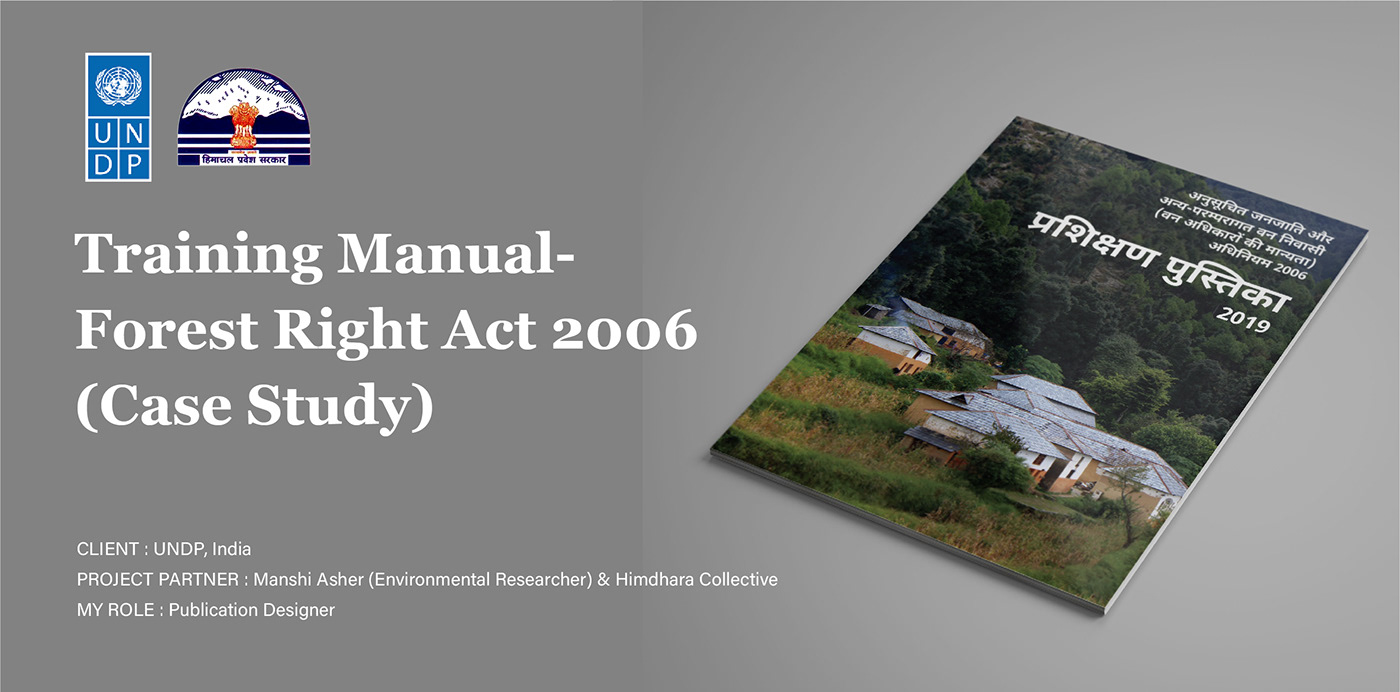
Project Brief :
Creating an interactive, easy to use Forest Right Act 2006 Training Manual in Hindi which is accessible and understandable for the locals of Himachal Pradesh. The manual aims at encompassing all necessary details and help them file claims successfully.

Sections :
Project Brief
Project Brief
1. What is Forest Right Act 2006 (FRA-2006)?
2. Why are the registrations low in Himachal Pradesh?
3. Research
4. Problems
5. Designing a Solution
6. Publishing and Distribution
Images from the workplace
2. Why are the registrations low in Himachal Pradesh?
3. Research
4. Problems
5. Designing a Solution
6. Publishing and Distribution
Images from the workplace

Source : http://www.himdhara.org/wp-content/uploads/2019/04/IMG_5577-770x430.jpg

The Scheduled Tribes and Other Traditional Forest Dwellers (Recognition of Forest Rights) Act,2006 (अनुसूचित जनजाति और अन्य-परम्परागत वन निवासी (वन अधिकारों की मान्यता) अधिनियम 2006) colloquially known as the Forest Rights Act or the Tribal Land Act is a law concerning the basic rights of the local communities of a region that dwell and earn their livelihood working in and around forests in their areas.
FRA has been implemented in Himachal Pradesh for years and a state where 70% area is forest land, requires active registrations as per FRA as most of its population depends on the green cover for farming and grazing.
FRA has been implemented in Himachal Pradesh for years and a state where 70% area is forest land, requires active registrations as per FRA as most of its population depends on the green cover for farming and grazing.

Source : http://www.himdhara.org/wp-content/uploads/2013/05/Capture.jpg


One of the major reasons why the number of registrations was incredibly low in the state was due to the lack of comprehension of the FRA law manual by the locals. The language of the guide book was highly sophisticated which made it difficult for locals to understand. Over 90-95% claims were rejected in 2018 because of mistakes in the form filling process



When I was approached for this project by UNDP, I was more than ecstatic to do something worthwhile for my community. In order to work efficiently and be cognizant of the opinions of the locals, I lived in Kandwari, a village close to Palampur, Himachal Pradesh for a month with Manshi Asher, an activist and environment researcher, who was the consultant on this project.
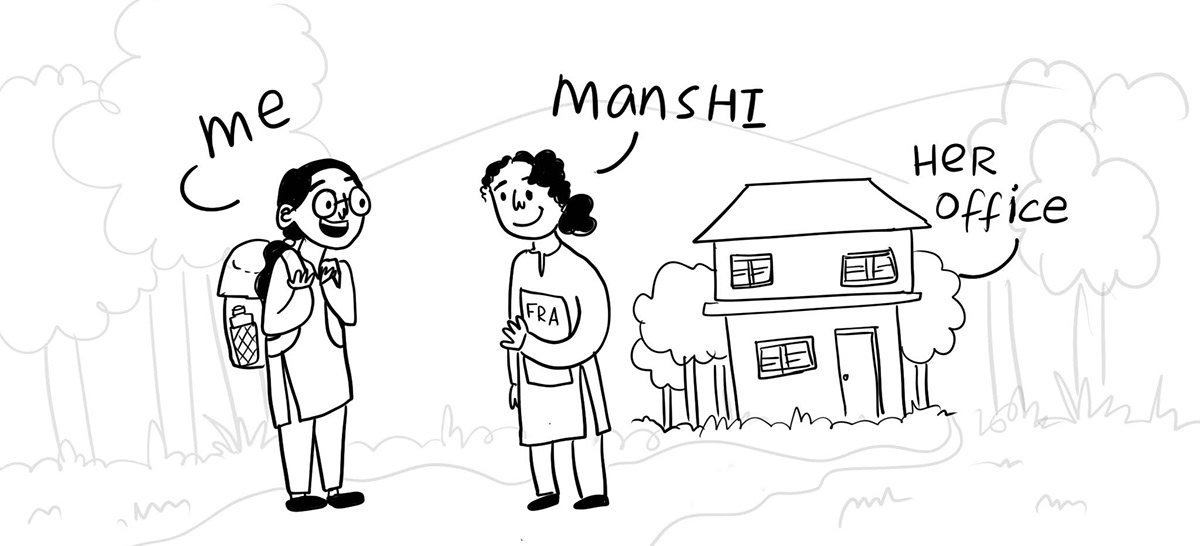
3.1. Living with the locals
We spent considerable time interacting with the locals, attended Gram Sabha, met all members of Gram Panchayat, and critically evaluated why there was such a huge gap between the FRA 2006 law and its enforcement.
We laid a lot of emphasis on observing their environments such as how and where the offices were located, how they conducted their meetings and organized events. We wanted to take insights from the lives of people we were working for such as their language, way of life, the area they were in, their knowledge about government procedures, and so forth. Our research was based not only on factual information but on the day to day events in the life of locals and how we could do everything in our power to simplify this process for them.
We laid a lot of emphasis on observing their environments such as how and where the offices were located, how they conducted their meetings and organized events. We wanted to take insights from the lives of people we were working for such as their language, way of life, the area they were in, their knowledge about government procedures, and so forth. Our research was based not only on factual information but on the day to day events in the life of locals and how we could do everything in our power to simplify this process for them.
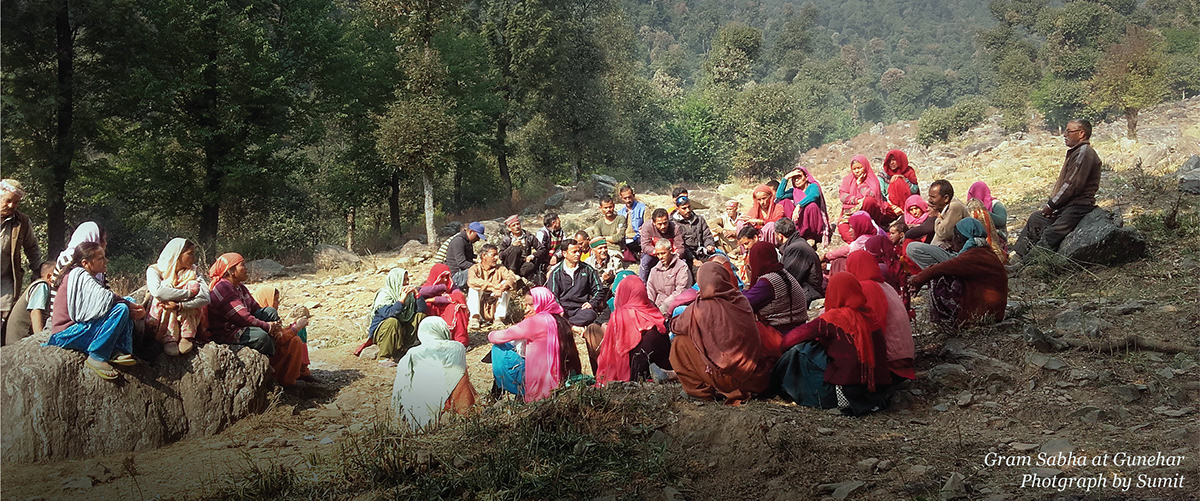
Spending time at the Gram Sabha of Gunehar
3.2. Existing Training Manual Resources
We carefully studied the existing Training Mnauals that UNDP got a few Training Manuals made like the one for the Orissa circle. It is in English and these books were used as resources in Himachal also. This was of little use as the stastics suggest.

Source : https://forestrights.nic.in/pdf/FRATrainingManual-2.pdf


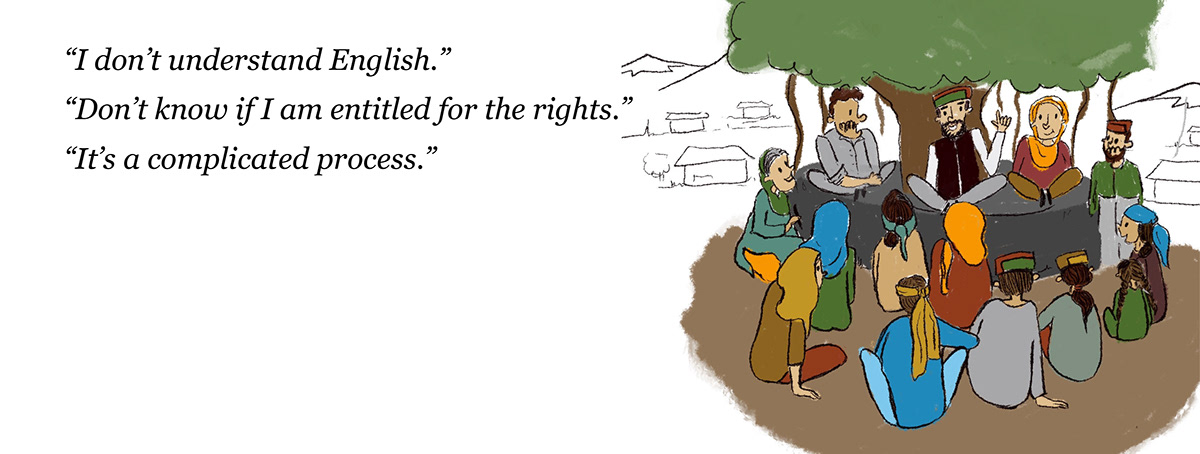
4.1. Difficult language of Law
Majority of the local population was not well-versed in English and that was the biggest hiccup for us. The language of the document was complicated and hence, it was difficult to comprehend for the few who knew English too.
4.2. Intimidating Process
Along with that, the process was intimidating and confusing for the people. They needed something can could constantly guide them through the process.
Along with that, the process was intimidating and confusing for the people. They needed something can could constantly guide them through the process.
4.3. Fear of Legal complications
People do not want to get into the complications of any legal practices and are not aware of legal jargon.
4.4. Single Copy per Gram Sabha
Another crucial issue was that a single copy of the manual was being used by the entire Gram Sabha and it was in a deplorable condition, desperately needing changes.
People do not want to get into the complications of any legal practices and are not aware of legal jargon.
4.4. Single Copy per Gram Sabha
Another crucial issue was that a single copy of the manual was being used by the entire Gram Sabha and it was in a deplorable condition, desperately needing changes.
4.5. How to fill the form
The residents of the village needed a simpler way to fill up forms, understand the whole process and, register themselves.
4.6. Repeated Queries
They faced other obstacles too like understanding categories to register themselves under and overlooking the repetitive FAQs.
The residents of the village needed a simpler way to fill up forms, understand the whole process and, register themselves.
4.6. Repeated Queries
They faced other obstacles too like understanding categories to register themselves under and overlooking the repetitive FAQs.


The next step after identifying the problems was coming up with a holistic solution that would cater to all the big and small issues faced by the locals. After careful deliberation, we decided that we had to create something that would be easy to read as well as be visually appealing for the people.
5.1. Content Restructure & Colour Coding
The content was restructured in 6 main sections and the sections were colour coded for easy access.

5.2. Information Graphics
The information was divided into a series of flowcharts, tables, and a comprehensive information structure for the Gram Sabha Members.
The information was divided into a series of flowcharts, tables, and a comprehensive information structure for the Gram Sabha Members.

5.3. A simple 9-Step Process
The process is divides in 9 steps with all the important details as follows-
i. what the process is (कार्यवाही),
The process is divides in 9 steps with all the important details as follows-
i. what the process is (कार्यवाही),
ii. who is responsible authority (भूमिका / ज़िम्मेदारी),
iii. a checklist of documents needed
iv. important points to be noted (ध्यान रहे),
iii. a checklist of documents needed
iv. important points to be noted (ध्यान रहे),
v. a checklist of things needed to be done before moving to the next step (अगले कदम से पहले निम्न कार्यवाही को ज़रूर पूरा कर लें),
vi. Sources from the law book (स्रोत)
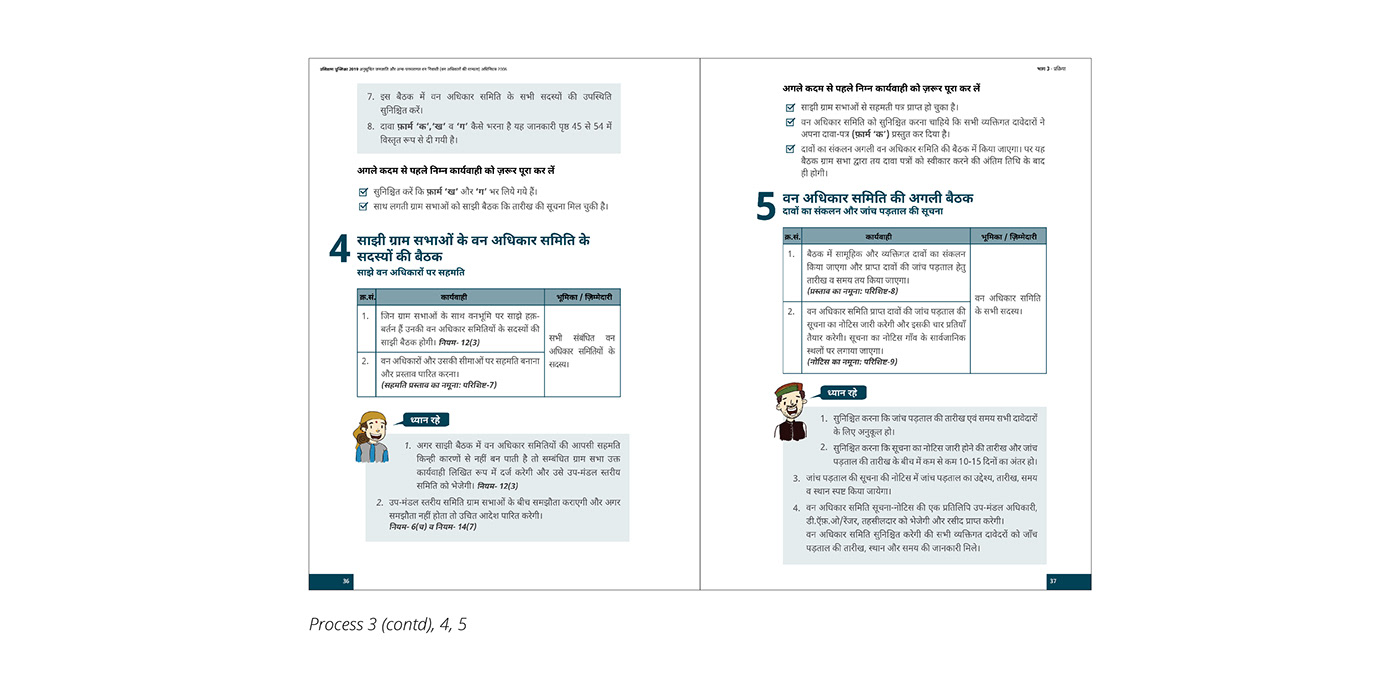
5.4. Demonstration on how to fill the form
The process of filling the form was simplified, making the whole layout more coherent for people. We introduced an explanation page in the manual to foster better understanding.

5.5. Local Illustrations
The visual design and layout were also enhanced with new additions such as graphics, pictures, and cartoons. Since Himachal Pradesh has many different cultures from different districts coming together, we took care of the diversity in our visual representations too.
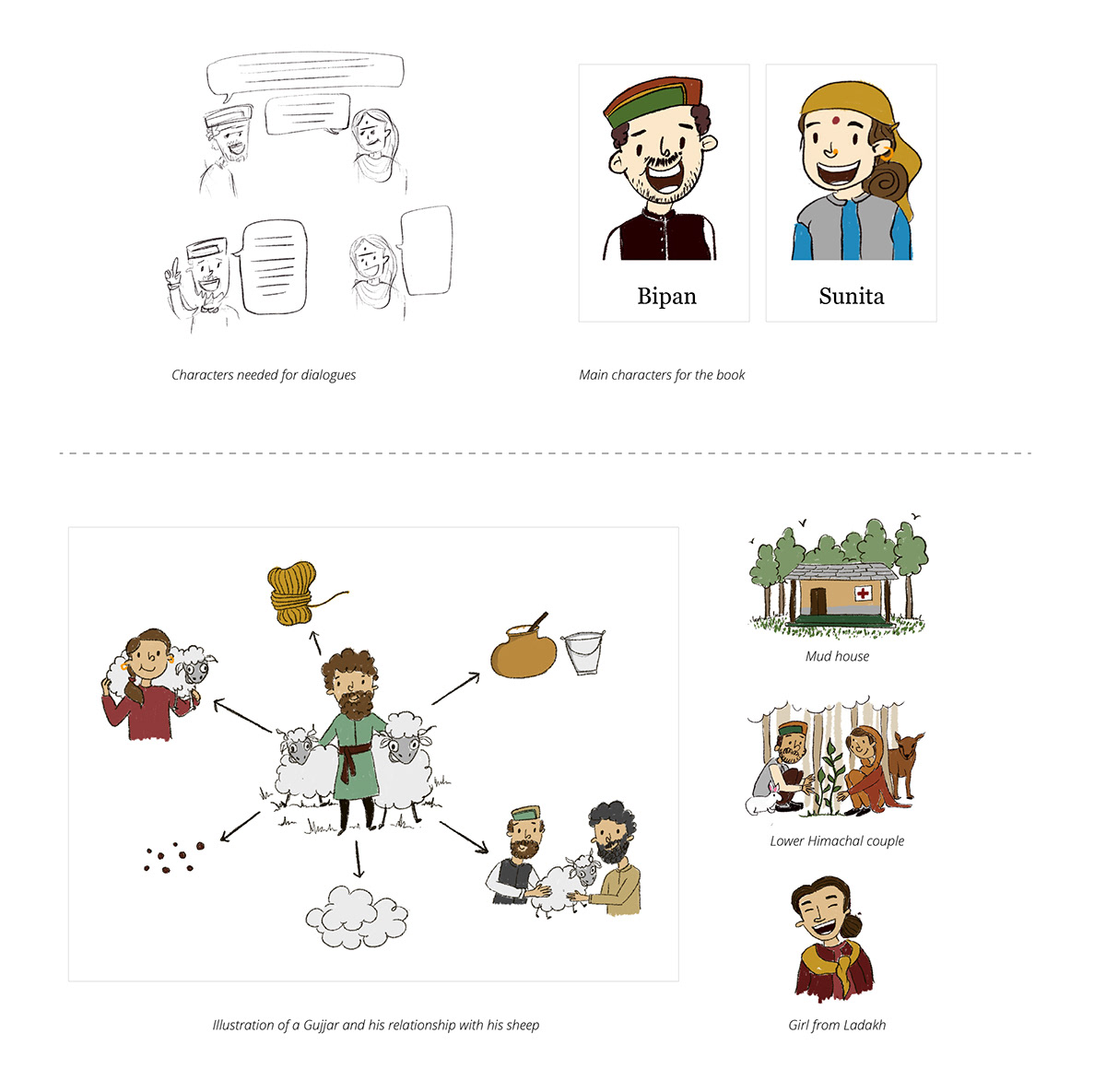
5.6. Durable physical copy of the book
Since these Training Manuals are mostly used in the Gram Sabhas that happen in the open and they are also subject to a lot of travel, a durable physical copy of the book was needed to sustain all that wear and tear.
i. We used Glossy paper for the book to save it from rains and dust.
Since these Training Manuals are mostly used in the Gram Sabhas that happen in the open and they are also subject to a lot of travel, a durable physical copy of the book was needed to sustain all that wear and tear.
i. We used Glossy paper for the book to save it from rains and dust.
ii. Pin binding for a steady grip
iii. No hardcover, so that it is easy to move around with.
iv. Book size A4: big enough to have all the content clearly placed and small enough to be carried around in bags.
iv. Book size A4: big enough to have all the content clearly placed and small enough to be carried around in bags.







After the final approval from UNDP, the manual was presented before officials of Ministry of Tribal Affairs (MOTA)in Shimla on January 28 th , 2020.


Currently it is distributed in various Gram Sabhas of Himachal Pradesh and it is also available on the website of Tribal Development Department of Himachal Pradesh. See here.

Here are some pictures from my time at Himdhara office, Kandwari







